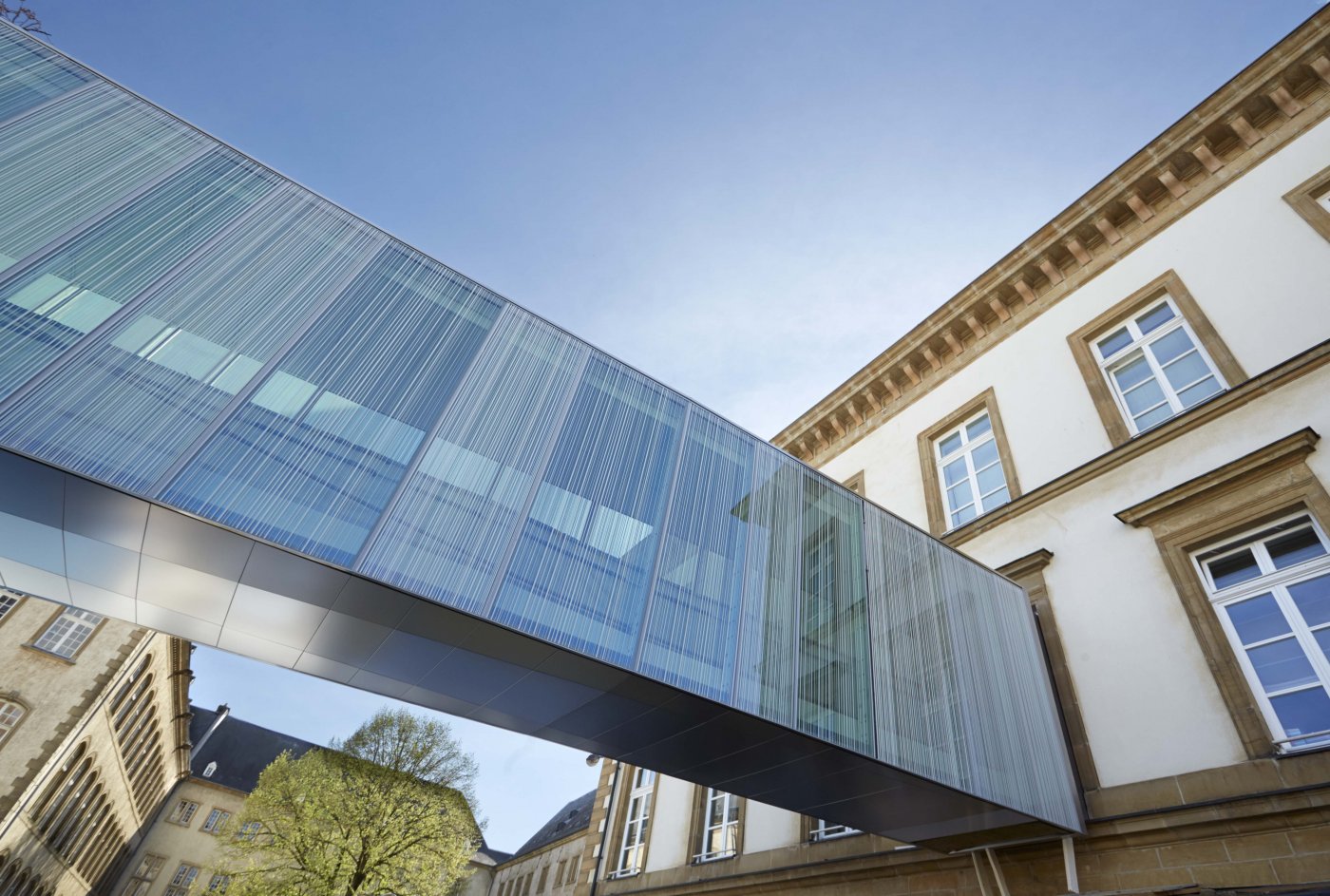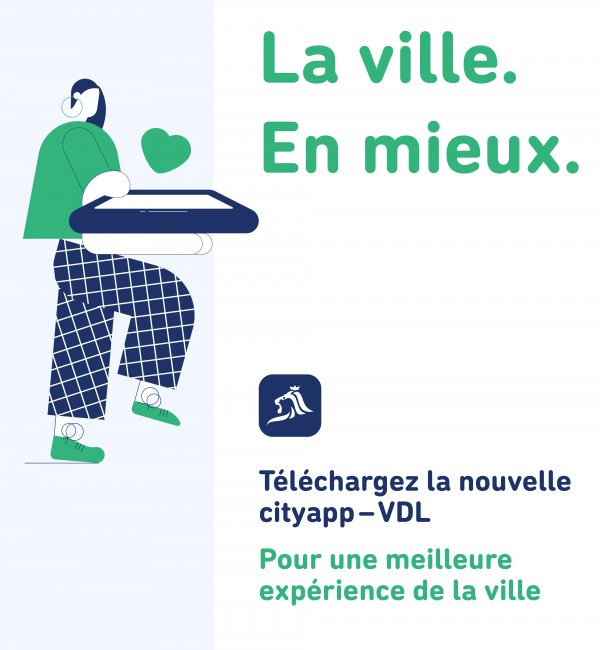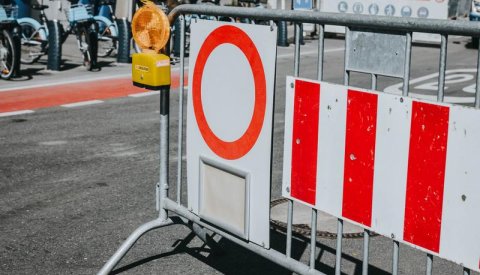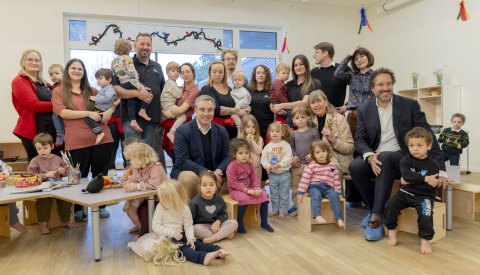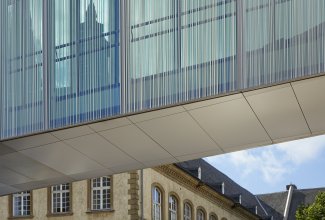Summary record
Video
Plans for the old Gare police station on Rue Glesener
Question by François Benoy
Although it will temporarily serve as the headquarters of the "House of Start-ups", a business incubator soon to open in the “Dôme” building on Rue du Laboratoire, the future of the old Gare police station in Rue Glesener is still unknown.
At the municipal council meeting on 10 July 2017, you said that the college of aldermen would "look at how to negotiate the early termination of the contract (for the operation of the car park, which runs until 2024) in exchange for compensation, with a view to demolishing the building so that the site could be used for a new housing development. Another option would be to carry out renovation and redevelopment works to convert it into housing. In this case, the college of aldermen would need to examine what is justifiable in terms of cost. The college of aldermen prefers the first option. In any case, the site would be well-suited to a development of some sort, given its accessible location and good public transport links."
As such, I would like to put the following questions to the college of aldermen:
- What plans does the college of aldermen currently have for this significant city-owned site on Rue Glesener?
Response by Lydie Polfer
The mayor replied that at one point it had been planned to use the building for start-ups, and the City had begun removing asbestos. However, the project was eventually abandoned owing to the exorbitant cost of the redevelopment works. There had also been a recent site visit with managers from "Hariko".
The building was currently a shell, and considerable investment would be needed to make it usable. Therefore, the college of aldermen preferred to concentrate on how to terminate the agreement with the car park operator, which is due to expire in 2024. This seems to be the only sensible solution, even though it would mean compensating the operator for loss of earnings.
Apart from the exorbitant cost of converting the existing building into housing, the building structure is not suited to this use.
Once the City manages to terminate the agreement, a housing development with street-level shops might be envisaged.
The Fieldgen private school has also embarked on plans to expand its canteen and would need a small plot of land for this purpose. Discussions are still to be held on this subject.
Future development of Kirchberg
Question by Paul Galles
On 22 March, plans were unveiled for the future development of the Kirchberg district. This interesting and ambitious project, which has garnered widespread media attention, will significantly increase both the number of residents (from 3,600 currently to 22,000 in the long term) and workers (from 38,000 currently to 65,000 in the long term). It is essential that a better balance is found between residents and workers, although the difference in absolute terms will increase by more than 8,000, from around 34,400 currently to 43,000 in the long term. This means that the scissors effect is no longer increasing at the same rate, but neither is it decreasing. Therefore, I would like to put the following question to the college of aldermen:
- What means does the City of Luxembourg have compared with Fonds du Kirchberg (Kirchberg Fund), the Ministry of Housing (Ministère du Logement) and the Ministry of Sustainable Development and Infrastructure (Ministère du développement durable et des infrastructures) of furthering our ambition of reducing the scissors effect between workers and residents?
- What land does the City of Luxembourg own in Kirchberg on which housing might be built?
- Compared with the purpose of the Fonds de la rénovation de la Vielle Ville (Historical City Centre Renovation Fund), is that of the Fonds du Kirchberg more limited? If so, and if the Fonds du Kirchberg were to close one day, what would this mean for the City of Luxembourg?
- Some interesting community projects have been launched in Kirchberg, including the Quartier Stuff. Could the City encourage these types of projects in Kirchberg's new neighbourhoods, and showcase them as a model for the city's other districts?
Response by Lydie Polfer
The mayor explained that the Fonds d'Urbanisation du Kirchberg (Kirchberg Urbanisation Fund) had been set up in the 1960s, at a time when virtually the entire Kirchberg plateau had been expropriated for the needs of the European institutions. It is managed by a board of directors, but is subordinate, in terms of policy, to the Ministry of Sustainable Development and Infrastructure. In addition, the Fonds d'Urbanisation du Kirchberg owns various plots of land and decides how they are to be used.
In the 1990s, banks moved into the upper section of the plateau, and the Fund sold the land under a long-term lease. In addition to European institutions and banks, it is also home to numerous office buildings and a shopping centre. There are undeveloped plots behind the RTL building and there are plans to move the Lycée Michel Lucius there, thus freeing up its current site in Limpertsberg. The vast Langfur plot is partly owned by the Fonds du Kirchberg and partly by private landowners.
A development plan is to be drawn up in conjunction with the Fund and the private landowners. The plan will mainly focus on housing, but also include offices and shops. There are plans to build residential developments along Boulevard Kennedy, on the right-hand side coming from the city centre. Since there has been some opposition from residents of Weimershof, a 30 m landscaped bed would be used to separate the two areas.
Arcelor Mittal is still planning to develop a large 55,000 m² site behind the Conference Centre, consisting almost entirely of offices.
Since the Fonds d'Urbanisation du Kirchberg had been set up under a 1961 law and is currently transferring its land under a 99-year lease, it should evidently continue operating during that time. By contrast, the Fonds pour la Rénovation de la Vieille Ville was dissolved after serving its purpose. In addition, each development plan in Kirchberg requires approval from the municipal council.
To clarify, the City owns half of the land in Schoettermarial, with the surface area given over to the development plan only a portion of this; it also owns small plots along Boulevard Konrad Adenauer, Rue de Kirchberg and Boulevard Prince Charles, and plots in the Langfur. Several homes are currently being built on municipal land: three houses in Rue de la Lavande and a single-family home on Val des Bons Malades.
Participatory housing
Question by François Benoy
In view of the following points, I would like to put the following questions to the college of aldermen:
In spring 2017, the City of Luxembourg launched two participatory housing projects (in Bonnevoie and Belair). The initiative was highly successful, with seven eligible applications received for the two available plots. On 27 March 2018, the selection committee chose two winning designs, currently in the detailed planning phase. The construction phase will follow.
- Where are matters up to with the two winning designs in this first participatory housing project?
- What conclusions have you drawn from the pilot participatory housing scheme in Luxembourg City?
There are numerous advantages to participatory housing: innovative social and environmental concepts with bespoke architecture and construction, reduced overheads (15–20%) compared with traditional developments, and a thriving residents' community. It is also an extremely rational approach to house-building on municipal land, since most of the work is done by the consortium rather than the City.
- Considering the numerous advantages of participatory housing, the shortage of housing in our city and the availability of municipal land (such as the "Baulücken"), when, how and how many participatory housing projects based on the consortium model will the City be launching in the short and medium term?
- What is your view on supporting and launching other forms of participatory housing, including cooperatives?
Response by Lydie Polfer
The mayor confirmed that thus far the participatory housing experiment had yielded positive feedback, and that two designs had been chosen.
In accordance with the requirements set out in the project specifications, the college of aldermen has recently interviewed the "Cohousing Bonneweg”" consortium, which submitted its building design for Rue Grenier in Bonnevoie. However, the financial aspect still needs to be clarified and the co-ownership rules still needs to be drawn up.
The college of aldermen has approved the submitted design, and this will be finalised over the summer. Construction could get under way in early 2019.
However, the college of aldermen has not yet received the other building design. Given that some local residents have raised objections, the college of aldermen has decided to meet with the consortium to discuss it. The municipal council will be kept informed of developments.
Ecole du Kiem
Question by Joël Delvaux
On 17 June 2018, the École du Kiem parents' committee, representing more than 500 parents of children at elementary schools in the Kiem, Weimershof and Weimerskirch districts, reported several infrastructural and logistical problems at these establishments.
The urgent points I wish to raise are as follows:
- Unbearably high temperatures in the containers being used as classrooms. The temperatures recorded by teaching staff range from 26° to 36° on sunny days.
- The current teaching resources are insufficient due to an increase in the number of children this year.
- The pedestrian crossing on Rue Anne Beffort is not in an ideal location. Already, two children have been involved in an accident while crossing the road from the containers to the foyer scolaire.
I would therefore like to put the following questions to the college of aldermen:
- What measures are envisaged to address the issue of high temperatures in the containers in hot weather?
- As the Kiem schools are already experiencing a steady increase in the number of new pupils, and considering the number of houses still being built, which will potentially lead to even higher pupil numbers, urgent action is needed. What plans are there to tackle the growing need for infrastructure and contingency for the Kiem district?
- In a bid to improve child safety and to avoid further accidents on Rue Anne Beffort, is it possible to move the pedestrian crossing opposite the school or at least install traffic-calming measures such as flower planters, speed bumps, etc.?
Response by Colette Mart
Alderwoman Mart said that she had recently had a meeting with a delegation from the Kiem parents' association, together with representatives from the Service Architecte-Maintenance (Architecture and Maintenance Department), Service Enseignement (Education Department), Service Foyers Scolaires (Childcare Department), Service Circulation (Traffic Department) and Service Parcs (Parks Department). Given that the population of this district and thus the number of children had increased, parents were questioning whether the staff and infrastructure were sufficient. The infrastructure audit and the provisional estimate of the increase in the number of pupils revealed a higher rate of growth than estimated a few years before.
The plans drawn up for a new school needed to be adapted, delaying construction. However, temporary structures have been put in place for the school and foyer scolaire, and a playground has been built.
For the 2017/2018 school year, there were six Cycle 1 classes and two early learning classes. A request had been lodged with the Ministry of Education, Children and Youth (Ministère de l'Education nationale, de l'Enfance et de la Jeunesse) to set up an additional class for the start of the next school year. Additional elementary school classes (Cycles 2–4) are also planned.
Parents also expressed their concerns about the high temperatures. These are due to the type of building, although solutions are being examined in conjunction with the Service Architecte. The possibility of installing air conditioning systems was considered, although these might also cause health issues for children and teachers. Therefore, the use of blinds was being considered as an alternative solution. It is important to be able to air the classrooms properly at night, though open windows could pose a security issue.
Regarding traffic, Kirchberg has a 30 km/h zone without pedestrian crossings, so the road could be crossed at any point. Municipal staff were on hand at school bus stops. There is a pedestrian crossing at the intersection of Boulevard Pierre Frieden and Rue Anne Beffort, so there is no point in having another pedestrian crossing 30 m away. It is recommended, therefore, that children should use the existing pedestrian crossing.
Lastly, new plans to expand the school campus will be submitted to the college of aldermen in the autumn. Parents of the schoolchildren concerned will be contacted in due course.
Foyer scolaire on Rue Verte, Cessange
Question by Sam Tanson
Following a previous question on 28 February 2018, the college of aldermen responded that on 5 March 2018, the new foyer scolaire on Rue Verte, Cessange would open after the Easter holidays. However, according to the information I have, the centre is still not open and there are rumours that it will not open until after the summer holidays. Parents are concerned about not having a place in the childcare centre by the start of the new school year.
In addition, the school playground still does not have any equipment.
I would therefore be grateful if you could answer the following questions:
- Why is the foyer scolaire still not an integral part of the premises on Rue Verte?
- Is it true that the foyer scolaire will not open in time for the start of the school year in September?
- What impact will this have on places available in the foyer scolaire, and how many children are currently on the waiting list?
- When will the school playground have equipment?
Response by Colette Mart
Alderwoman Mart pointed out that this question had already been raised, and that no new information was available. The City has taken the necessary steps to obtain authorisation, but is still waiting for a response from the Inspectorate of Labour and Mines (Inspection du travail et des mines – ITM) – in particular, the summary report and approval, as well as feedback from other government stakeholders.
She reiterated the information given in February, i.e. that since 2013, the conditions for opening a foyer scolaire had become much stricter. As the City is not responsible for producing the required documents, it cannot be said at this stage when the centre will open. To be more specific, this involves a final inspection by other authorities.
However, it is still hoped that the centre might open in time for the start of the school year in September.
In terms of enrolment, if the new temporary building on Rue Verte is ready by September, this would leave six children on the waiting list in Cessange. Obviously any children whose parents have no alternative childcare option would be accepted.
If the new building is not ready by the start of the school year, this would leave 18 children on the waiting list. In this case, the container on Rue St. Joseph would continue to be used.
There are currently 35 children on the waiting list, although this could definitely be reduced. However, a few places would have to be kept in reserve for children with no alternative care, who would be identified over the summer months. A total of 219 applications were received for the 2018/2019 school year, and there was capacity at the centre for 266 children.
Given the staff available, 213 children could be accommodated at lunchtime and 154 during the afternoon. There are 24 places available for preschool, and 187 for the other cycles.
Lastly, the playground has been delayed as the person in charge of the project has left the Service Architecte, which is in charge of its construction. The project is being handled by the Service Architecte in conjunction with the Service Parcs.
Response by Lydie Polfer
The mayor finished by saying that the ITM will be reminded to send the necessary report.
Historic Hôtel des Postes building at the Centre Aldringen
Question by Sylvia Camarda
Since last week, the historic Hôtel des Postes building has been the subject of intense debate on social media, in the press and in the Chamber of Deputies. The conversation revolves around the future of this Renaissance-style building, built in 1908–1910 by the government-commissioned architect Sosthène Weis. In 2017, a design competition was launched to give this listed building a new lease of life. The winner was Vincent Callebaut, who had the idea of converting it into a mixed-use building with offices, shops and apartments, with a glass dome roof inspired by the Reichstag. However, this project was later rejected. The City of Luxembourg then wanted to turn the Hôtel des Postes into a luxury hotel, but the redevelopment work proved to be too extensive. I would therefore like to put the following questions to the college of aldermen:
- What will happen to this wonderful building?
- What will it be used for?
- Is Vincent Callebaut's idea being re-examined?
- Is a new design competition feasible?
- Could the building be used by artists until the renovation work starts, given the shortage of arts centres in the city centre?
Response by Lydie Polfer
The mayor confirmed that the Hôtel des Postes was indeed a historic building which had opened in 1910, designed by the architect Sosthène Weis and built by Achille Giorgetti, and that had been built on top of a part of the old fortress. The building has been vacant for several months, since Post had decided to consolidate its offices in the Gare and Gasperich districts. However, Post's management wants to keep a post office in the city centre.
In 2016, a competition was held and Vincent Callebaut's design, which included shops, offices and housing, had been chosen. However, the project involved a glass dome which was out of keeping with the existing building. The municipal departments pointed out that the glass roof would not be permitted, as the building is situated in the Ville Haute conservation area and has national listed status. The engineering departments had also expressed reservations over the tree-lined terrace which was part of the design. A model was presented on 22 June 2017. The Service Urbanisme requested details of how the restaurant beneath the glass roof would be accessed, but received no response.
At a meeting on 22 June 2017 with the Minister of the Economy (ministre de l’Économie) and the Director General of Post, the City argued that the building was an ideal candidate for a hotel, considering its city centre location and the future tram link. Nothing more was heard until 9 May 2018, when the Director General of Post requested a meeting. At this meeting, it was explained that it would be difficult to convert the building into a hotel, mainly because of its large rooms and concerns about profitability. However, he indicated that he would accept the City and State's decision to go ahead with the hotel project.
In the end, the Callebaut project was abandoned and the architects in charge of the project were informed. The City is committed to making the best use of the building. The suggestion that it be used temporarily by artists is a good idea in the circumstances, although it is up to the minister in charge of the postal service to approve it.
